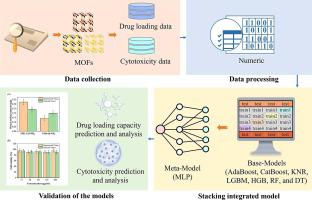当前位置:
X-MOL 学术
›
Int. J. Pharm.
›
论文详情
Our official English website, www.x-mol.net, welcomes your feedback! (Note: you will need to create a separate account there.)
The drug loading capacity prediction and cytotoxicity analysis of metal–organic frameworks using stacking algorithms of machine learning
International Journal of Pharmaceutics ( IF 5.8 ) Pub Date : 2024-04-15 , DOI: 10.1016/j.ijpharm.2024.124128 Yang Wang , Liqiang He , Meijing Wang , Jiongpeng Yuan , Siwei Wu , Xiaojing Li , Tong Lin , Zihui Huang , Andi Li , Yuhang Yang , Xujie Liu , Yan He
International Journal of Pharmaceutics ( IF 5.8 ) Pub Date : 2024-04-15 , DOI: 10.1016/j.ijpharm.2024.124128 Yang Wang , Liqiang He , Meijing Wang , Jiongpeng Yuan , Siwei Wu , Xiaojing Li , Tong Lin , Zihui Huang , Andi Li , Yuhang Yang , Xujie Liu , Yan He

|
Metal–organic frameworks (MOFs) have shown excellent performance in the field of drug delivery. Despite the synthesis of a vast array of MOFs exceeding 100,000 varieties, certain formulations have exhibited suboptimal performance characteristics. Therefore, there is a pressing need to enhance their efficacy by identifying MOFs with superior drug loading capacities and minimal cytotoxicity, which can be achieved through machine learning (ML). In this study, a stacking regression model was developed to predict drug loading capacity and cytotoxicity of MOFs using datasets compiled from various literature sources. The model exhibited exceptional predictive capabilities, achieving R values of 0.907 for drug loading capacity and 0.856 for cytotoxicity. Furthermore, various model interpretation methods including partial dependence plots, individual conditional expectation, Shapley additive explanation, decision tree, random forest, CatBoost Regressor, and light gradient-boosting machine were employed for feature importance analysis. The results revealed that specific metal atoms such as Zn, Cr, Fe, Zr, and Cu significantly influenced the drug loading capacity and cytotoxicity of MOFs. Through model validation encompassing experimental validation and computational verification, the reliability of the model was thoroughly established. In general, it is a good practice to use ML methods for predicting drug loading capacity and cytotoxicity analysis of MOFs, guiding the development of future property prediction methods for MOFs.
中文翻译:

使用机器学习堆叠算法进行金属有机框架的载药量预测和细胞毒性分析
金属有机框架(MOF)在药物输送领域表现出了优异的性能。尽管合成了大量超过 100,000 个品种的 MOF,但某些配方仍表现出次优的性能特征。因此,迫切需要通过识别具有优异载药能力和最小细胞毒性的 MOF 来提高其功效,这可以通过机器学习(ML)来实现。在这项研究中,开发了一个堆积回归模型,使用从各种文献来源汇编的数据集来预测 MOF 的药物负载能力和细胞毒性。该模型表现出卓越的预测能力,载药能力的 R 值为 0.907,细胞毒性的 R 值为 0.856。此外,采用部分依赖图、个体条件期望、Shapley加性解释、决策树、随机森林、CatBoost回归器和光梯度提升机等多种模型解释方法进行特征重要性分析。结果表明,Zn、Cr、Fe、Zr 和 Cu 等特定金属原子显着影响 MOF 的载药能力和细胞毒性。通过包括实验验证和计算验证在内的模型验证,彻底建立了模型的可靠性。总的来说,使用机器学习方法来预测MOF的载药能力和细胞毒性分析是一种很好的做法,可以指导MOF未来性能预测方法的发展。
更新日期:2024-04-15
中文翻译:

使用机器学习堆叠算法进行金属有机框架的载药量预测和细胞毒性分析
金属有机框架(MOF)在药物输送领域表现出了优异的性能。尽管合成了大量超过 100,000 个品种的 MOF,但某些配方仍表现出次优的性能特征。因此,迫切需要通过识别具有优异载药能力和最小细胞毒性的 MOF 来提高其功效,这可以通过机器学习(ML)来实现。在这项研究中,开发了一个堆积回归模型,使用从各种文献来源汇编的数据集来预测 MOF 的药物负载能力和细胞毒性。该模型表现出卓越的预测能力,载药能力的 R 值为 0.907,细胞毒性的 R 值为 0.856。此外,采用部分依赖图、个体条件期望、Shapley加性解释、决策树、随机森林、CatBoost回归器和光梯度提升机等多种模型解释方法进行特征重要性分析。结果表明,Zn、Cr、Fe、Zr 和 Cu 等特定金属原子显着影响 MOF 的载药能力和细胞毒性。通过包括实验验证和计算验证在内的模型验证,彻底建立了模型的可靠性。总的来说,使用机器学习方法来预测MOF的载药能力和细胞毒性分析是一种很好的做法,可以指导MOF未来性能预测方法的发展。



























 京公网安备 11010802027423号
京公网安备 11010802027423号